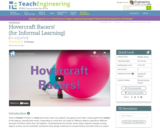
Students learn about friction and its effects on motion by building model hovercrafts.
- Subject:
- Education
- Material Type:
- Lesson Plan
- Provider:
- TeachEngineering
- Provider Set:
- TeachEngineering
- Date Added:
- 10/14/2015

Students learn about friction and its effects on motion by building model hovercrafts.

Students are introduced to a challenge question. Towards answering the question, they generate ideas for what they need to know about medicines and how they move through our bodies, watch a few short videos to gain multiple perspectives, and then learn lecture material to obtain a basic understanding of how antibiotics kill bacteria in the human body. They learn why different forms of medicine (pill, liquid or shot) get into the blood stream at different speeds.
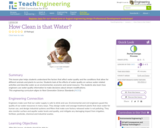
This lesson plan helps students understand the factors that affect water quality and the conditions that allow for different animals and plants to survive. Students will look at the effects of water quality on various water-related activities and describe water as an environmental, economic and social resource. The students will also learn how engineers use water quality information to make decisions about stream modifications.
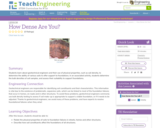
Students learn about geotechnical engineers and their use of physical properties, such as soil density, to determine the ability of various soils to offer support to foundations. In an associated activity, students determine the bulk densities of soil samples, and assess their suitability to support foundations.
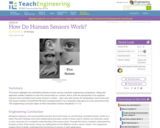
This lesson highlights the similarities between human sensors and their engineering counterparts. Taking this approach enables students to view the human body as a system, that is, from the perspective of an engineer. Humans have recreated most human sensors in robots – eyes, ears and sensors for temperature, touch and smell. The lesson inculdes a PowerPoint file that is programmed to run a Jeopardy-style game as a fun assessment tool.
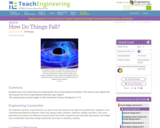
Students learn more about forces by examining the force of gravitational attraction. They observe how objects fall and measure the force of gravitational attraction upon objects.
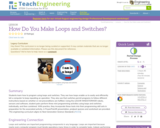
Students learn how to program using loops and switches. They see how loops enable us to easily and efficiently tell a computer to keep repeating an operation. They also see that switches permit programs to follow different instructions based on whether or not preconditions are fulfilled. Using the LEGO MINDSTORMS(TM) NXT robots, sensors and software, student pairs perform three mini programming activities using loops and switches individually, and then combined. With practice, they incorporate these tools into their programming skill sets in preparation for the associated activity. A PowerPoint® presentation, pre/post quizzes and worksheet are provided.
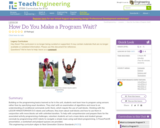
Building on the programming basics learned so far in the unit, students next learn how to program using sensors rather than by specifying exact durations. They start with an examination of algorithms and move to an understanding of conditional commands (until, then), which require the use of wait blocks. Working with the LEGO MINDSTORMS(TM) NXT robots and software, they learn about wait blocks and how to use them in conjunction with move blocks set with unlimited duration. To help with comprehension and prepare them for the associated activity programming challenges, volunteer students act out a maze demo and student groups conclude by programming LEGO robots to navigate a simple maze using wait block programming. A PowerPoint® presentation, a worksheet and pre/post quizzes are provided.
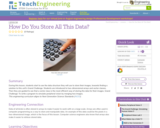
During this lesson, students start to see the data structure they will use to store their images, towards finding a solution to this unit's Grand Challenge. Students are introduced to two-dimensional arrays and vector classes. Then they are guided to see that a vector class is the most efficient way of storing the data for their images. Grand Challenge: To write a program to simulate peripheral vision by merging two images.

Students learn more about how light sensors work, reinforcing their similarities to the human sense of sight. They look at the light sensing process incoming light converted to electrical signals sent to the brain through the human eye anatomy as well as human-made electrical light sensors. A mini-activity, which uses LEGO MINDSTORMS(TM) NXT intelligent bricks and light sensors gives students a chance to investigate how light sensors function in preparation for the associated activity involving the light sensors and taskbots. A PowerPoint® presentation explains stimulus-to-response pathways, sensor fundamentals, and details about the LEGO light sensor, including its two modes of gathering data and what its numerical value readings mean. Students take pre/post quizzes and watch a short online video. This lesson and its associated activity enable students to gain a deeper understanding of how robots can take sensor input and use it to make decisions via programming.
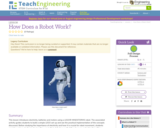
This lesson introduces electricity, batteries and motors using a LEGO® MINDSTORMS NXT® robot. The associated activity guides students to build a simple LEGO NXT set-up and see the practical implementation of the concepts discussed. Before studying the importance of electricity and how it is crucial for robot movement, students consider various electronic devices they use in their daily lives so that they have an understanding of how engineers use electricity to power such devices, including robots. The lesson starts with a brief introduction to electricity and the working of batteries. A simple electrical circuit demonstration highlights how three basic electrical devices (buzzer, LED and motor) are driven by electricity. An activity at the end further reinforces these concepts.
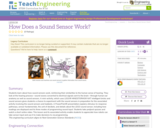
Students learn about how sound sensors work, reinforcing their similarities to the human sense of hearing. They look at the hearing process sound waves converted to electrical signals sent to the brain through human ear anatomy as well as sound sensors. A mini-activity, which uses LEGO MINDSTORMS(TM) NXT intelligent bricks and sound sensors gives students a chance to experiment with the sound sensors in preparation for the associated activity involving the sound sensors and taskbots. A PowerPoint® presentation explains stimulus-to-response pathways, sensor fundamentals, the unit of decibels, and details about the LEGO sound sensor, including how readings are displayed and its three modes of programming sound input. Students take pre/post quizzes and watch a short online video. This lesson and its associated activity enable students to appreciate how robots can take sensor input and use it to make decisions to via programming.

Students learn about how touch sensors work, while reinforcing their similarities to the human sense of touch. They look at human senses and their electronic imitators, with special focus on the nervous system, skin and touch sensors. A PowerPoint® presentation explains stimulus-to-response pathways, how touch sensors are made and work, and then gives students a chance to handle and get familiar with the LEGO touch sensor, including programming LEGO MINDSTORMS(TM) NXT robots to use touch sensor input to play music. Students take pre/post quizzes and watch a short online video. The mini-activities prepare students for the associated activity. This lesson and its associated activity enables students to appreciate how robots can take input from sensors, and use that to make decisions to move.
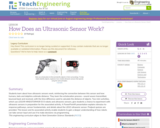
Students learn about how ultrasonic sensors work, reinforcing the connection between this sensor and how humans, bats and dolphins estimate distance. They learn the echolocation process sound waves transmitted, bounced back and received, with the time difference used to calculate the distance of objects. Two mini-activities, which use LEGO MINDSTORMS(TM) NXT robots and ultrasonic sensors, give students a chance to experiment with ultrasonic sensors in preparation for the associated activity. A PowerPoint® presentation explains stimulus-to-response pathways, sensor fundamentals, and details about the LEGO ultrasonic sensor. Pre/post quizzes are provided. This lesson and its associated activity enable students to gain a deeper understanding of how robots can take sensor input and use it to make decisions via programming.
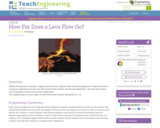
While learning about volcanoes, magma and lava flows, students learn about the properties of liquid movement, coming to understand viscosity and other factors that increase and decrease liquid flow. They also learn about lava composition and its risk to human settlements.
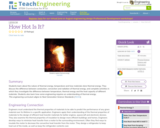
Students learn about the nature of thermal energy, temperature and how materials store thermal energy. They discuss the difference between conduction, convection and radiation of thermal energy, and complete activities in which they investigate the difference between temperature, thermal energy and the heat capacity of different materials. Students also learn how some engineering requires an understanding of thermal energy.
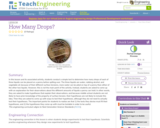
In this lesson and its associated activity, students conduct a simple test to determine how many drops of each of three liquids can be placed on a penny before spilling over. The three liquids are water, rubbing alcohol, and vegetable oil; because of their different surface tensions, more water can be piled on top of a penny than either of the other two liquids. However, this is not the main point of the activity. Instead, students are asked to come up with an explanation for their observations about the different amounts of liquids a penny can hold. In other words, they are asked to make hypotheses that explain their observations, and because middle school students are not likely to have prior knowledge of the property of surface tension, their hypotheses are not likely to include this idea. Then they are asked to come up with ways to test their hypotheses, although they do not need to actually test their hypotheses. The important points for students to realize are that 1) the tests they devise must fit their hypotheses, and 2) the hypotheses they come up with must be testable in order to be useful.

Students will study through investigation the effects of light pollution on night sky observation. They will share their results and suggest improvement within the community.
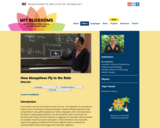
In this lesson, we learn how insects can fly in the rain. The objective is to calculate the impact forces of raindrops on flying mosquitoes. Students will gain experience with using Newton's laws, gathering data from videos and graphs, and most importantly, the utility of making approximations. No calculus will be used in this lesson, but familiarity with torque and force balances is suggested. No calculators will be needed, but students should have pencil and paper to make estimations and, if possible, copies of the graphs provided with the lesson. Between lessons, students are recommended to discuss the assignments with their neighbors.
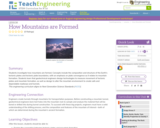
Students investigate how mountains are formed. Concepts include the composition and structure of the Earth's tectonic plates and tectonic plate boundaries, with an emphasis on plate convergence as it relates to mountain formation. Students learn that geotechnical engineers design technologies to measure movement of tectonic plates and mountain formation, as well as design to alter the mountain environment to create safe and dependable roadways and tunnels.